Performance Practice
of Electroacoustic Music
Ash Fure
Shiver Lung
Ash Fure
Shiver Lung (2016) for ensemble and electronics
Shiver Lung was premiered by the International Contemporary Ensemble on 11 May 2016 in New York. Scored for two sopranos, alto saxophone, bassoon, violoncello, two percussion players and electronics, the work presents material which later became a central component of the installation opera The Force of Things: An Opera for Objects (2017) created by Ash and Adam Fure, a transdisciplinary work in which several artists from the fields of music, architecture and theatre have participated.
Shiver Lung retains a strong scenic aspect through the spatial disposition and the gestural actions demanded from the musicians. In addition to playing their instruments, the instrumentalists located at five points at the periphery of the space are asked to produce sounds by performing meticulously described and notated actions on open speaker cones. These are driven by oscillators at a subsonic frequency of 10,67 Hz. Hands, fingers, and numerous other objects are hit by the oscillating surfaces, the inherent dramaturgical quality of which is underscored by Fure’s introductory remarks on the piece:
“A ring of subwoofers encircles the audience, projecting soundwaves too low to hear until performers slide the flesh of their hands across each palpitating surface, pulling the soundwaves into the realm of the audible.” [http://www.ashleyfure.com/shiver-lung]
Two female singers standing back to back in the centre of the space perform vocal techniques through bullhorns including unvoiced, aspirated whispers and sung tones. Close to them, an additional pair of subwoofer cones specifically prepared with cymbals create a spatial counterpoint.
The genesis of the piece took the form of a collective process involving members of the New York based International Contemporary Ensemble (Ross Karre, Levy Lorenzo, Alice Teyssier, Lucy Dhegrae Rebekah Heller, Ryan Muncy, and Kivie Cahn-Lipman. [Karre 2020a, 1:35] working together closely with the composer in an experimental exploration of sound production. [4:00] Referring to this process, Ross Karre postulates a democratisation in terms of creating a very specific sound character through many participants [16:25] and relating to authorship and agency [18:35], but also in the way the audience can relate to the musician’s actions on the speaker cones, which require different skills than that of instrumental virtuosity. [19:30]
Subsequently, Fure composed pieces with the same title for different instruments: Shiver Lung 2 for solo percussion and electronics (2017), Shiver Lung 3 for subs and sounds (2018), all of which entailed the exploration of expressivity and timbre as a fundamental part of their creation process. [15:55]
In Shiver Lung for ensemble and electronics, the five-part form is articulated by the use of speaker cones and pre-produced sequences played back through loudspeakers surrounding the audience. Slow transformation processes with increasing intensity as well as spectral morphing and transitions are characteristic features. Formal articulation is marked by interruptions and contrasts, by alternating and combining sections with rhythmical, oscillating figures and passages based on slight pitch differences aiming to generate beatings and unexpected spectral events.
Delicate and very quiet events on the not yet activated speaker cones and whispering sounds in the voices are predominant in the initial section. The activation of the sinus oscillators is followed by the introduction of various playing techniques and actions on the membranes, first with the hands, then using paper. Slowly oscillating sung tones and pitched sounds as well as a lap-steel guitar electromechanically coupled to a tam-tam appear in the third section. Additional objects are introduced. The gradual activation of both speaker cones in the centre and the sound files creates a transition to section four, the most dense and intense of the piece. Here, a slowly ascending motion in the voices is counterpointed by the low violoncello and bassoon. The pre-recorded sounds add layers of vocal, instrumental and percussion sounds, while noisy, semi-improvised actions are taking place on the cones. The piece ends with a short contrasting coda with only three vocal sounds separated by long silences reminiscent of the piece’s beginning.
The precise rhythmical notation, the steady subsonic frequency of the speaker cones and the use of a click track might at first glance suggest an interest in rhythmical patterns and strict articulation. However, the intended character is rather that of a “lazy”, breathing gesture [c.f. Karre 2020b, 41:20] with precise degrees of sonic variance derived by Fure in the creation process and further varied and explored in each new iteration. This is expressly encouraged through annotations in the score inviting the performers e.g. to “explore the harmony spectrum”, “allow the note to break into a spectral event”, “explore different rates of beating”, “continually morph from one vowel to the next”, etc. The mechanical, shivering movement of the speaker cones is shaded by organic oscillating movements and gestures at different formal and temporal levels.
The exploration of sonic phenomena as well as the creation of performative situations based on the development of dispositives involving objects and electromechanical devices make references to the work of composers such as Alvin Lucier and Peter Ablinger. [Karre 2020a, 33:30– 35:14] However, the focus in Shiver Lung lies on the audible, tangible and visible materiality of bodies interacting with objects and the resulting gestural quality of sound, rooted in a collective and interdisciplinary explorative project. This and the openness of the process without preconceived programmatic narratives or structural precepts gives the work cycle along with the opera The Force of Things a specific character very much resonating with the rich tradition of experimental music in the United States.
Performance Materials
a) Score and parts:
Composer’s edition, 2016
Source: Ash Fure
Format: pdf
Now published with Edition Peters, EP 68702
Publication date: February 2020
The score contains the following:
– Information concerning the instrumentation
– Spatial diagram with explanations about distribution of the musicians and the setup in the performance space
– Description and pictures of the technical gear
– Instructions for the singers regarding vocal techniques, bullhorn techniques and explanation of the notation
– Instruction regarding the manipulation of subwoofer cones with explanations about notation
– Instructions for each instrument
– Specific instructions for percussion players with a description of the setup for the lap steel guitar
– Short description of the electronics
– Performance score with notation for the ensemble. It includes a layer indicating the changes in the electronics
b) Other materials:
Patch
Source: Ash Fure
Date: 2017
Title: Shiver Audio
Author: Ash Fure
System: Max 8
File: Shiver_Max_Zazo. Maxpat
Ground plan
Source: Ash Fure
Author: Ash Fure
File: 20200117_ShiverLung_GroundPlan.pdf
Original stage plan with additional information including
-Microphone placement on the stage
-Audio mixer input list (microphones for amplification/laptop)
-Audio mixer output list (speakers, click)
Auctorial Instructions
A computer running Max/MSP is needed with an audio interface with at least eight outputs (five 15’’ woofers, 2 12’’ woofers and click track). The Max patch controls the woofers, the audio file playback and the click track.
The minimum requirement for sound diffusion is a stereo setup in the front of the venue. It is possible to mirror the stereo channels on two additional loudspeakers positioned in the back of the venue.
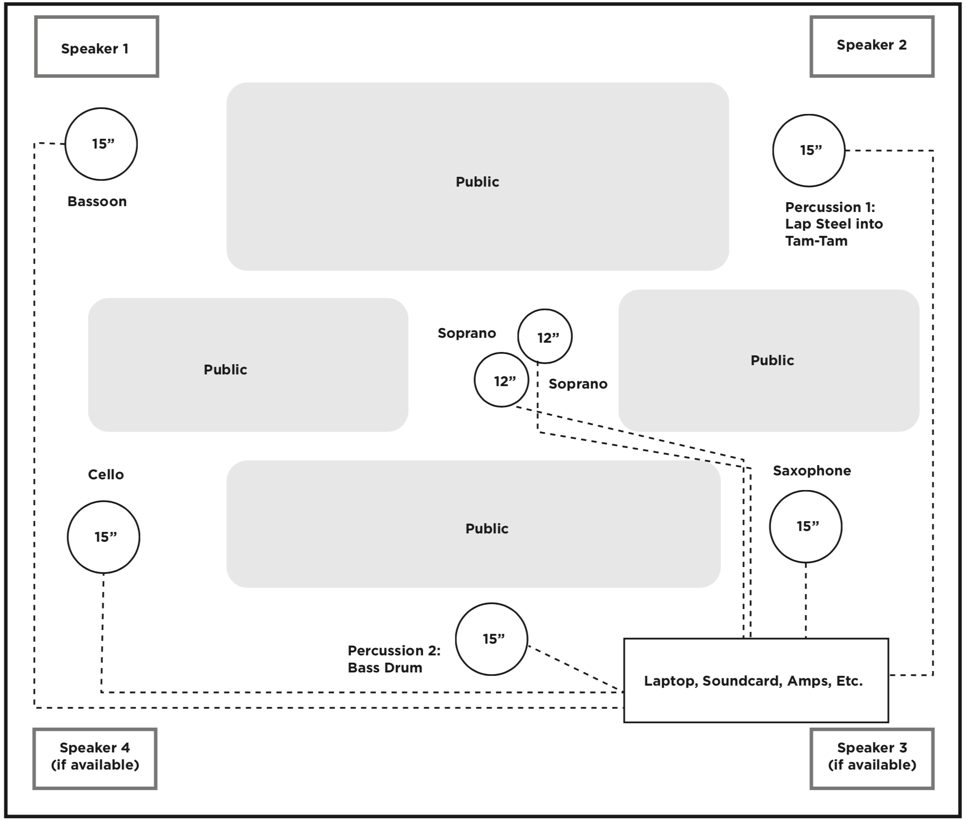
Fig. I. Spatial diagram (s. above, score)
The five musicians are placed around the hall: Bassoon (front left), percussion I (front right), saxophone (back right), percussion II (back centre) and cello (back left). The two singers are placed in the middle of the room facing opposite directions. Each of the five musicians has a 15’’ woofer next to her or him, the two 12” woofer cones prepared with cymbals (s. below) are placed between the singers.
Performance remarks by Ross Karre
The players are required to perform specific actions on the speaker membranes using their fingertips, fingernails, the palms of their hands, a piece of paper, and other objects. While these playing techniques are described in the score, some specific details remain open. The following explanations, given by Ross Karre at a workshop rehearsal at ICST [c.f. Karre 2020c & Karre 2020d], provide additional guidance.
1. “Sharp scrape of fingernails” on the surface of the diaphragm of the speaker cones should produce a kind of audible downward glissando; e.g. bar 18 and bars 21–23.
2. “Trail fingertips back and forth across the soft rim of the speaker”
The sliding movement made with the fingertips on the rim of the speaker cone must be performed exactly on the border of the diaphragm and never on the rubber band on the frame of the speaker cones (e.g. bars 40–48).
3. Handling the bullhorns:
In order to avoid generating feedback though the bullhorn, a suitable volume level and appropriate distance between mouth and bullhorn must be found. If the bullhorns have buttons to produce sounds like alarm signals etc., these must be disabled to avoid unexpected effects during the performance.
4. Palm slide: this movement can be thought of as a kind of diminuendo. It should start fast and finish slow (e.g. saxophone from bar 29).
5. Concerning the figures in the bass drum (percussion 2) at the end of bars 21, 22 and 23: Do a soft movement with the fingers changing the spectral quality of the sound and producing a sort of pitch shifting. Generally, the produced sound should generate a harmonic spectrum similar to that of the human voice when changing from the vowels “e“ to “o“.
6. Starting at bar 46 the hands move independently from one another, the players doing this without coordination between them in order to create a more dense texture. The maximum density occurs at bar 56.
7. Bow slide on the lap steel guitar (percussion 1): Very fast movement; playing half on the wood and half on the hairs of the bow (col legno tratto), producing a sound rich in overtones (e.g. bar 65).
8. Holding paper above and parallel to the speaker cone after bar 78: The height should be at the point of audibility; the players then move it gently down and back. The tautness of the paper is the second variable that players can work with. The musicians should coordinate the movement with eye contact. If it proves difficult to detach and reattach the paper, an extra piece of paper can be used for this passage.
9. “Laziness” – The figures in the voices bars 86 and 87 can be slower, “wrong on purpose”, resulting in a rubato of sorts.
10. Bow for percussion 1: the percussion player plays on the tam-tam half on the wood and half on the hairs of the bow (col legno tratto), eventually changing bow pressure in order to explore possibilities for timbral changes.
11. Voices: the sound of the last figures in bars 105 (s-p-t) and 107 (s-f-p-t) should be produced in one breath and articulated like a word.
12. In bar 116 voices and bassoon have the same material. In the bassoon it should sound like the spatial echo of the singers.
13. All voices after bar 135: the s-f-s-f can sound quite lazy and is produced on one breath and not articulating the consonants separately. Rotation of bullhorns can be quite fast in order to articulate the different parts of the space.
14. The last “f” before bar 143 should not be too short. The last figures (s-f-s-f) can be thought of as a big tenuto ending.
15. Bar 144: After the long pause the voices can start either later (in that case emerging from the instrumental sounds) or softer, so as to realise the entry at the niente level indicated in the score.
16. The last s-f in bar 177 can be realised tenuto and with quite a big sound, so as to mark the following cut-off into silence.
17. The very last s-fuh at the end of the piece can be somewhat slower than written.
Performance report
The concert took place on 17 January 2020 at ZHdK’s concert hall No. 1 (KS 1) with Kara Leva and Hannah Mehler, voice, Joan Jordi Oliver, saxophone, Luca Staffelbach, Cédric Gyger, percussion, Francisco Bautista Ortega Arenas, bassoon, Alex Jellici, violoncello and Leandro Gianini, sound engineering. Ross Karre, percussionist and (now emeritus) Artistic Co-Director of the International Contemporary Ensemble, who had from the start been involved in the genesis of the piece, worked with the group during the last stage of the rehearsal process.
While members of the International Contemporary Ensemble envision extended forms of notation for this and other pieces including moving images and audio for the future to document specific playing techniques [Karre 2020, Talk, 26:14], the presence of Ross Karre at the workshop was crucial for this group of performers to better understand specific setting details, playing techniques, the intention of the present notation and the overall character of the piece.
Special instruments
15’’ woofer
The devices used were:
Woofer: Monacor SP-382PA
Amplifier: L-Acoustics LA4X
It is important to verify that the amplifiers can reproduce a frequency as low as 10 Hz.
The woofers were placed on wooden pedestals. Between the woofer and the pedestal and between the pedestal and the floor isolation materials such as foam were placed to minimise noise caused by the mechanical movement of the woofer.
Objects used on the woofer
Paper:
The main difficulty here is how to hold the paper (A3 size) on the top of the woofer and how to attach and detach it quickly. This movement should be rehearsed carefully; some experimentation will be necessary to find the best way to do it as silently as possible. The way described in the score is a suggestion and not inevitably the best. For example, in Shiver Lung 2 foamcore frames to hold the paper were introduced. This solution might also be applied to Shiver Lung.
Aquarium gravel in a plastic bag:
The plastic bag should not be too thick, and the amount of gravel not excessive in order to avoid the bouncing sound of the gravel to be dampened.
12’’ half styrofoam ball (only cello and percussion I):
By varying the pressure applied to the half ball with the fingers different harmonic structures can be generated.
Foam core:
The foam core should be rigid. The playing technique is similar to the one used for the styrofoam half ball.
Auxiliary objects:
This is handled quite freely. For this performance China cymbals in combination with different kinds of chains, keys, wooden sticks, ping pong balls and rattles were used mostly.
12’’ woofers
Woofer: Monacor SP-302E
Amplifier: L-Acoustics LA4X
The two woofers are located in the middle of the space close to the singers. A 12’’ China cymbal is placed on top of the woofers. Between the cymbal and the rim of the woofer four coins are placed to allow the cymbal to resonate. A carton guard attached to the rim helps to keep the cymbal in place when it starts vibrating.
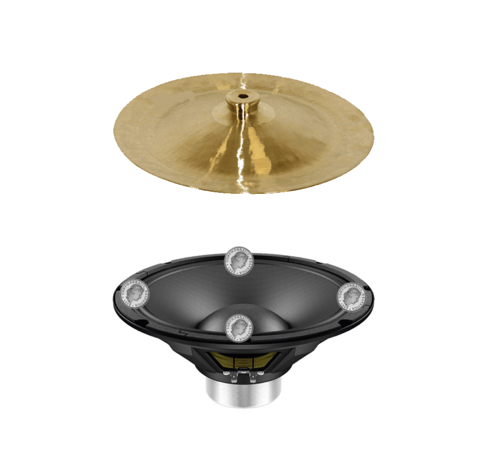 |
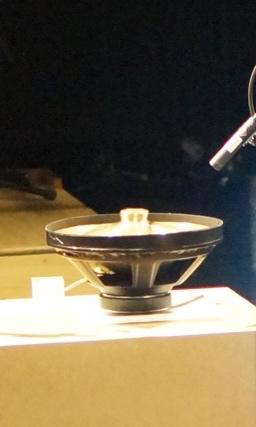 |
Fig II. 12’’ woofer and placement of China cymbal
In order to set the loudness of the woofer it is important to make sure that the crescendo at bar 143 starts quasi dal niente and that it will not become too loud. The risk of blowing a speaker is quite high in this section. Also, the pianissimo at the end of the piece (bar 178) should still be clearly audible. If setting one constant volume from start to end does not give a satisfying result, it is possible to change the lines range in the patch itself.
Lap steel guitar
Lap steel guitar: Harley Benton Slider II Lap steel
Amp: Marshall Mini-Amps MS-2
Transducer: Bass Egg
Bow: Cello
The lap steel guitar was connected to a mini amplifier. The phone output of the amplifier was then connected to the bass egg. The bass egg was mounted to the dampening system of the Kolberg tam-tam stand. This allowed to quickly experiment with the bass egg placement and the amount of pressure applied to the tam-tam.

Fig. III. Mini amplifier connected to bass egg
Bullhorns
Megaphone: SpeaKa Professional XB-7S
The bullhorns had integrated sounds and a siren. It might be advisable to remove the plastic knobs to avoid accidentally playing these sounds.
Loudspeaker setup and amplification
We used four L-Acoustics 8XT and one Meyersound 700 HP subwoofer to play back the sound files. In the score’s technical notes no amplification of the instruments is described. However, a microphone setup plan was provided by Ross Karre [cf. Sources, other materials], indicating that each woofer, instrument and the singers should be amplified. While the document doesn’t specify the placement of the speakers, Ross Karre in an E-Mail pointed out that the microphones should be routed to the main speakers or, if a surround array is available, according to the position.
For the amplification of the musicians and of the five 15’’ woofers we used one L-Acoustics 8XT close to each of them. The microphones for the woofers were placed at 4-5 cm from the woofer. We used Neumann KM 184 microphones with windscreens to minimise the wind effect caused by the paper on the woofers.
The loudspeakers were placed behind the musicians at a height of approximately 2 metres. The five musicians were placed on stage platforms with a height of 40 cm. For amplification of the two singers and of the two 12“ woofers two L-Acoustics 8XT were hung in the middle of the space, above the singers. The crescendo at bar 143 started without any amplification. The amplification of the centre and periphery woofers was added gradually to match the volume of the tape and the live instruments at bar 144.
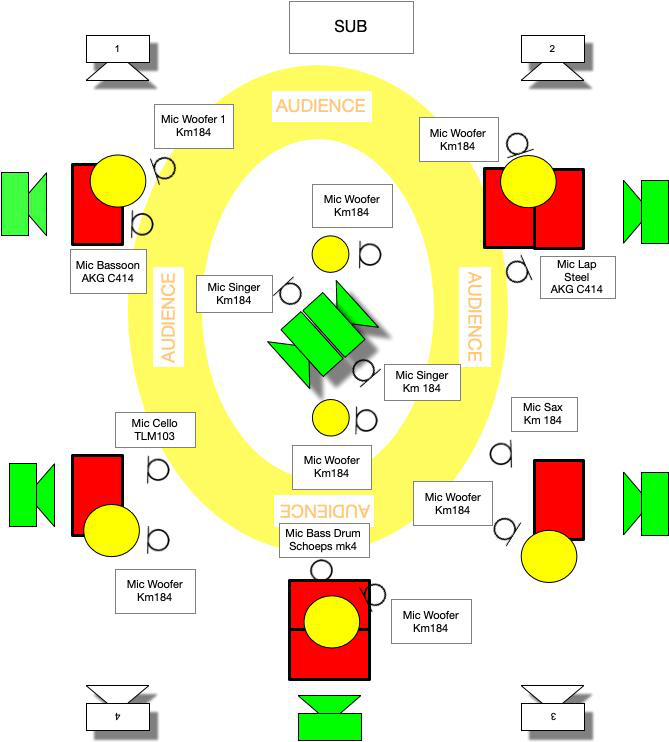
Fig. IV. Microphone and speaker setup
The bass drum microphone was also routed to the subwoofer, but only used for the beginning of the piece (bar 1-28; especially b. 1-4)
Reverberation
Reverberation is needed mainly for the singers and for the instruments. Ross Karre pointed out that the quality of the reverb should be long and bright.
We used a Bricasti M7 reverb unit (preset: Mechanical hall, 2.2 s, pre-delay 30ms.). Equalisation and compression were added to the output of the reverb. The stereo output was then routed to the speakers close to the musicians and to the centre speakers.
Retrospectively, the reverberation system worked well, but it could certainly be improved. A setup with more than one stereo reverb unit could improve the general result and allow to have a different reverb setting between singers and instruments.
Synchronisation
The musicians are synchronised with the woofers and the audio playback by a click track. We used a museum guide type wireless system with on-ear headphones to enable the musicians to move freely and hear themselves and the other musicians more clearly.
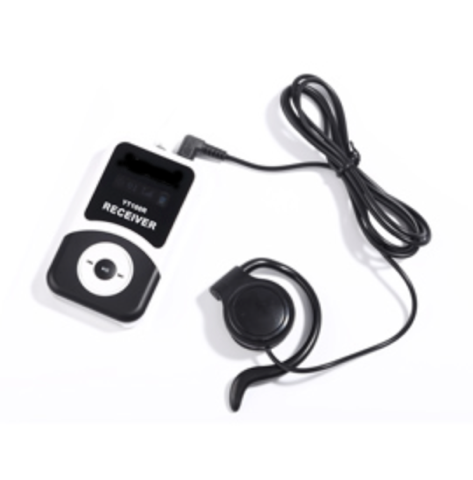
Fig. V. Museum guide type wireless system
To prevent the click from being audible to the audience and to improve the contact between the musicians, the click volume was adjusted from the FOH.

Fig. VI. Fader movement for the click track. The exact gain amount depends on the equipment used.
Stage and Lights
The exact stage and light concept will be based on the given space and performance situation. Each musician was illuminated by a spot. During the transition to the 4th section the light is switched off (bar 143) and the audience is left in total darkness until the instruments start again (bar 144).
We started the performance with the bass drum already playing an almost inaudible roll amplified by the subwoofer while the audience were taking their seats in the hall. When everybody was seated the click track would be started and the piece could begin.
Rehearsals
As the instruments used are not conventional (woofer/lap steel guitar), it would be advisable to allow for the musicians to be able to practice individually and not only in group. This could be achieved by giving direct access to the equipment or organising individual rehearsing time slots.
Composer’s website: http://www.ashleyfure.com/shiver-lung [last accessed 15 November 2023]
Karre, Ross (2020a): Interview. Conducted by Germán Toro Pérez, 16 January 2020.
Karre, Ross (2020b): Talk. Given at ICST workshop, 16 January 2020.
Karre, Ross (2020c): Coached rehearsal session at ICST workshop, 16 January 2020.
Karre, Ross (2020d): Ross Karre Shows techniques of Shiver Lung, 14 January 2020.
-last update: 15 November 2023